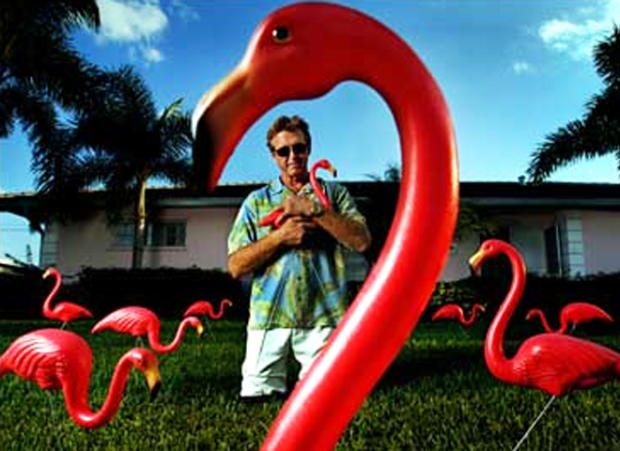Extinction threatens pink flamingo
The pink plastic flamingo, a Florida-inspired icon that has been reviled as kitschy bad taste and revered as retro cool, is dead at age 49.
The pop culture symbol met its demise after its manufacturer, Union Products, of Leominster, Mass., was socked with a triple economic threat - increases in costs of electricity and plastic resin combined with loss of financing.
Production ended in June, and the plant is scheduled to close Nov. 1, according to president and CEO Dennis Plante. Union Products made 250,000 of its patented plastic pink flamingos a year in addition to other garden products.
Robert Thompson, professor of popular culture at Syracuse University, paid tribute to the infamous bird that has been immortalized everywhere - from the John Waters' movie "Pink Flamingos," to bachelor parties and lawns across America.
"Let's face it," he said. "As iconic emblems of kitsch, there are two pillars of cheesy, campiness in the American pantheon. One is the velvet Elvis. The other is the pink flamingo."
The birth of the plastic pink flamingo in 1957 coincided with the booming interest in Florida, Thompson said, making it possible for those in other parts of the country to have a little piece of the Sunshine State's mystique in their yard.
By the late '70s, according to Thompson, the pink flamingo became a symbol of bad taste. It was considered trash culture and embraced by folks with a wise-guy attitude. They knew better (wink, wink) but embraced the iconic symbol anyway.
By the late '80s and early '90s, he said, we learned to make fun of pop culture items such as the pink flamingo as well as appreciate them.
"The pink flamingo has gone from a piece of the Florida boom and Florida exotica to being a symbol of trash culture to now becoming a combination of all we know - kitsch, history, simplicity and elegance," Thompson said.
2Until recently, Mike Smollon was one of the folks who put the pink flamingo in the kitsch category. But during a recent trip to Massachusetts, the Boynton Beach firefighter and battalion chief had an epiphany.
After reading a story in the Sentinel & Enterprise (Fitchburg, Mass.) about the closing of the factory, he bought 12 pairs of flamingos.
"I never owned a pink flamingo before," Smollon said. "To be honest, I used to think this was the kind of a thing only a girl would put in her yard. But when I found out the factory was closing, I thought, this is something historical happening."
Smollon went to the factory and bought 11 sets of pink flamingos and one set of the commemorative gold flamingos that were made for 2007, which would have been the bird's 50th birthday. He planned to keep a few and give the rest to flamingo-loving friends.
Then, flamingo fever hit him hard, and he searched the Internet for Don Featherstone, the kitschy bird's creator. When he learned that Featherstone lived only about five minutes from his hotel, he called him and asked if he could come over and get his photograph taken with him.
Not only did Featherstone and his wife, Nancy, come out of the house wearing matching pink shirts adorned with green flamingos, the artist autographed two sets of flamingos. Smollon also bought a copy of Featherstone's book, "The Original Pink Flamingos: Splendor on the Grass," which he autographed for an extra $5.
After Smollon returned home, he bought a set of pink flamingos from the 1950s for $39 on eBay.
"Now I have one of the first sets made and one of the last sets made," he said. "I have my own private collection."
Featherstone retired as president of Union Products about six years ago, but he still promotes his creation and will continue to do so post-mortem.
On Oct. 5, he spoke on what would have been the upcoming 50th anniversary of Featherstone's plastic pink flamingo at the Ig Nobel prizes at Harvard University. The Ig Nobels, a parody of the Nobel prizes, are given for achievements that "first make people laugh and then make them think," according to Improbable Research, creator of the awards. Featherstone was honored in 1996 for his creation, which he originally sculpted from clay based on a National Geographic photograph.
Several folks besides Smollon have stopped by to see Featherstone and get their pictures taken with him.
"They think the pink flamingos could be extinct, and they think I will be extinct soon, too," he said. "It is sad that it is happening, but it may not be dead yet."
Featherstone and Plante are hoping for a resurrection. Plante has been seeking another company to buy the molds. So far, two companies in the U.S. and one in Canada have expressed interest.
"I am hoping that someone will come forward and save the plastic pink flamingo from extinction," Plante said.
Until then, you can buy them on eBay, where they were selling for $12.95 and $17.56 recently. In comparison, Smollon paid $15 for a set of two pink flamingos and $25 for a set of gold flamingos.
"I can't imagine that there won't be any way to get a pink flamingo anywhere but on eBay," said pop culture professor Thompson. "We are so much into a big retro craze. All the Baby Boomers are looking mortality in the eye, and there is so much nostalgia for the things of their childhood, such as old toys and candy.
"When the news gets out that you can't get them anymore, I think there will be a demand," Thompson says. "It may not be the demand there was before, but there will be demand as a specialty item."
Revived or not, the pink plastic flamingo is sure to live on in the pop culture hall of fame.
